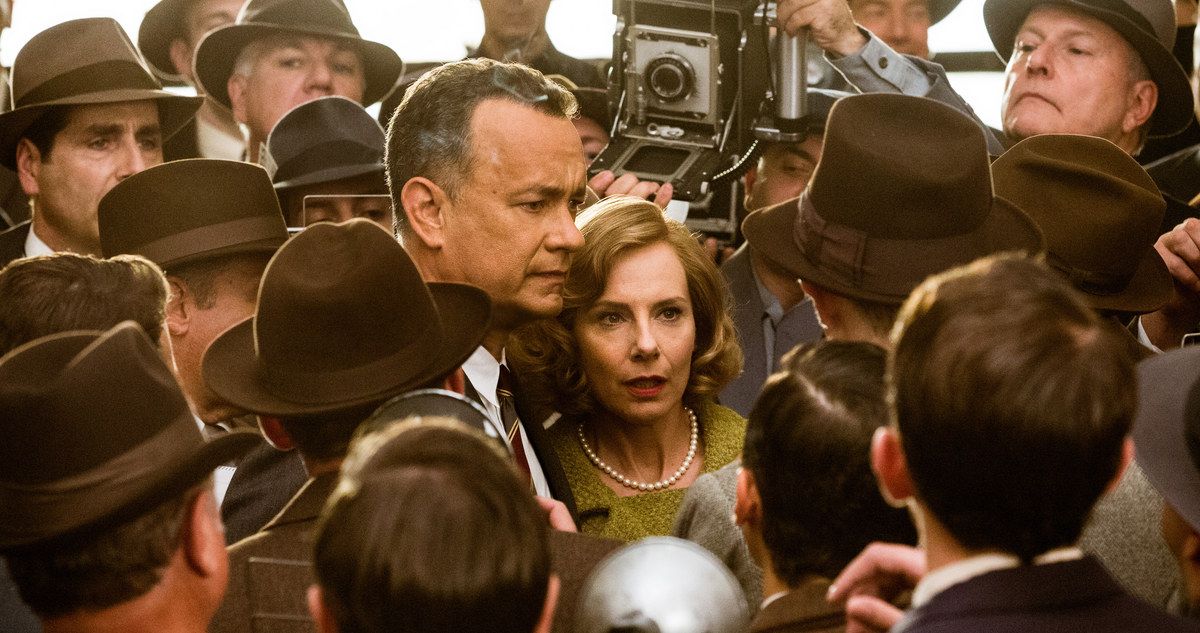Bridge of Spies is an expertly crafted espionage thriller from Steven Spielberg. It frames the stark ideological battle of The Cold War and the dangerous nuclear ramifications of any misstep. In a world filled with distrust and fear, Bridge of Spies successfully portrays the virtue of principle. The infiltration of foreign agents into American society was an insidious threat. However, the response to that threat, The Red Scare, was equally a test to our democratic ideals.
On the morning of June 21, 1957; the FBI arrested Rudolf Abel (Mark Rylance) in Brooklyn, New York as an undeclared agent for the Soviet Union. Abel, an unassuming artist, had been under surveillance as a Russian spy for quite some time. The US Justice Department deemed the case as a cut and dry prosecution, but wanted a capable defense for public consumption. Abel's case was given to James B. Donovan (Tom Hanks), a prominent insurance lawyer who had been a prosecutor during the Nuremburg Trials of World War Two. Donovan realizes the evidence against Abel is insurmountable, but is shocked at the tactics used by the government. He launches a spirited defense of Abel on constitutional grounds, much to the dismay of his law partners, the government, and his family. Donovan is branded a communist sympathizer by the press, with public scorn and outrage quick to follow.
During this time, the United States was engaging in top secret aerial photography of the Soviet Union with the high altitude U-2 aircraft. On May 1, 1960; Francis Gary Powers (Austin Stowell) was shot down over Russia flying a U-2 mission. He was captured, convicted in a kangaroo court, and paraded in front of the world as an American spy. The CIA, afraid that Powers would start hemorrhaging classified material, had to get him back. They decided a prisoner exchange, Powers for Abel, would be the best solution for both countries. But the US government could not acknowledge Powers or the existence of the U-2 project. Donovan was asked to secretly negotiate the swap with the Soviets. He flew, as a civilian with no official cover, into East Germany at the dawn of the Berlin Wall. His mission to recover Powers was not only dangerous, but complicated by the East German capture of an American student, Frederic Pryor (Will Rogers).
Bridge of Spies is not a ten pages of script and a bang movie. The screenplay by Math Charman and the Coen Brothers is absolutely superb. It is a methodical, precise staging of events. Donovan's concern regarding the government's treatment of Abel is the clear message. What makes us Americans; our values, the adherence to the rule of law, the belief that the constitution is the bedrock of this country, in war or peace. Executing Abel for espionage would have been shortsighted. Donovan foresaw his value as a foreign asset. The drama unfolds powerfully with these arguments.
The collaboration here between Steven Spielberg and Tom Hanks is on par with their efforts in the classic Saving Private Ryan. Bridge of Spies is that good. It is the next chapter in the story of America's World War Two generation. They won the battle for freedom, but had to face an internal reckoning, away from the battlefield. The performances are extraordinary. The masters, Spielberg and Hanks, deftly guide a talented ensemble. Mark Rylance is Oscar worthy as the stoic Rudolf Abel. Janusz Kaminski, Spielberg's longtime cinematographer, with production design by Adam Stockhausen, paints a portrait of a world on the edge. From the Berlin Wall to the classrooms where children were taught to 'duck and cover', the palpable fear of The Cold War is present in every scene.
Most audiences will have no knowledge of Francis Gary Powers and the U-2 incident. It was a pivotal historical event that could have led to a nuclear war. Calmer heads prevailed. Where even in deep existential conflict, rationality and common ground can be reached. James Donovan was a man for all ages. Bridge of Spies is a testament to his beliefs and one of the best films of the year.

